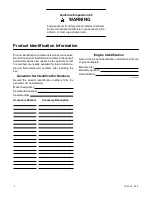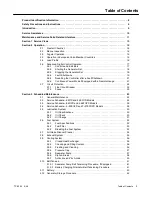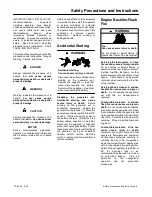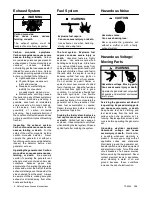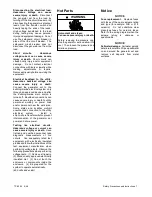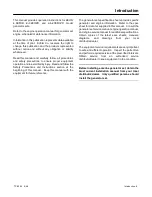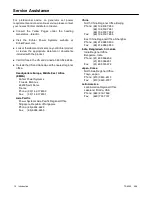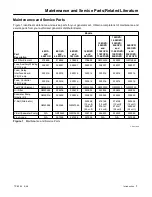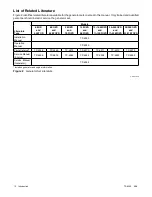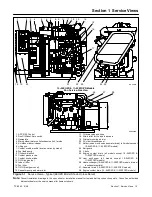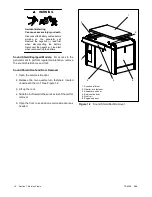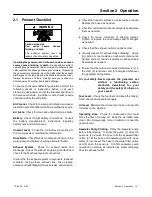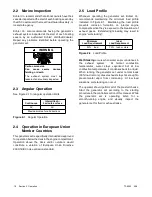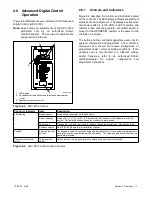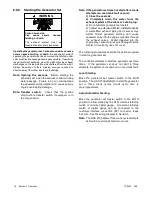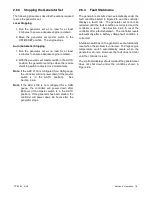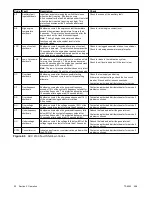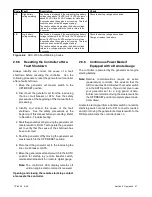
TP-6252 2/08
6 Safety Precautions and Instructions
Exhaust System
Carbon monoxide.
Can
cause
severe
nausea,
fainting, or death.
The exhaust system must be
leakproof and routinely inspected.
WARNING
Carbon
monoxide
symptoms.
Carbon monoxide can cause severe
nausea, fainting, or death.
Carbon
monoxide is a poisonous gas presentin
exhaust gases. Carbon monoxide is an
odorless,
colorless,
tasteless,
nonirritating gas that can cause death if
inhaled for even a short time. Carbon
monoxide poisoning symptoms include
but are not limited to the following:
D
Light-headedness, dizziness
D
Physical fatigue, weakness in
joints and muscles
D
Sleepiness, mental fatigue,
inability to concentrate
or speak clearly, blurred vision
D
Stomachache, vomiting, nausea
If experiencing any of these symptoms
and carbon monoxide poisoning is
possible, seek fresh air immediately
and remain active. Do not sit, lie down,
or fall asleep. Alert others to the
possibility of carbon monoxide
poisoning. Seek medical attention if
the condition of affected persons does
not improve within minutes of breathing
fresh air.
Inspecting the exhaust system.
Carbon monoxide can cause severe
nausea, fainting, or death.
For the
safety of the craft’s occupants, install a
carbon monoxide detector.
Never
operate the generator set without a
functioning carbon monoxide detector.
Inspect the detector before each
generator set use.
Operating the generator set. Carbon
monoxide can cause severe nausea,
fainting, or death.
Be especially
careful if operating the generator set
when moored or anchored under calm
conditions because gases may
accumulate. If operating the generator
set dockside, moor the craft so that the
exhaust discharges on the lee side (the
side sheltered from the wind). Always
be aware of others, making sure your
exhaust is directed away from other
boats and buildings.
Fuel System
Explosive fuel vapors.
Can cause severe injury or death.
Use extreme care when handling,
storing, and using fuels.
WARNING
The fuel system. Explosive fuel
vapors can cause severe injury or
death.
Vaporized fuels are highly
explosive. Use extreme care when
handling and storing fuels. Store fuels
in a well-ventilated area away from
spark-producing equipment and out of
the reach of children. Never add fuel to
the tank while the engine is running
because spilled fuel may ignite on
contact with hot parts or from sparks.
Do not smoke or permit flames or
sparks to occur near sources of spilled
fuel or fuel vapors. Keep the fuel lines
and connections tight and in good
condition. Do not replace flexible fuel
lines with rigid lines. Use flexible
sections to avoid fuel line breakage
caused by vibration. Donot operatethe
generator set in the presence of fuel
leaks, fuel accumulation, or sparks.
Repair fuel systems before resuming
generator set operation.
Draining the fuel system. Explosive
fuel vapors can cause severe injury
or death.
Spilled fuel can cause an
explosion. Usea containerto catchfuel
when draining the fuel system. Wipeup
spilled fuel after draining the system.
Hazardous Noise
Hazardous noise.
Can cause hearing loss.
Never operate the generator set
without a muffler or with a faulty
exhaust system.
CAUTION
Hazardous Voltage/
Moving Parts
Hazardous voltage.
Can cause severe injury or death.
Operate the generator set only when
all guards and electrical enclosures
are in place.
Moving parts.
WARNING
Servicing the generator set when it
is operating. Exposed moving parts
can cause severe injury or death.
Keep hands, feet, hair, clothing, and
test leads away from the belts and
pulleys when the generator set is
running. Replaceguards, screens,and
covers before operating the generator
set.
Grounding electrical equipment.
Hazardous voltage can cause
severe injury or death.
Electrocution
is possible whenever electricity is
present. Ensure you comply with all
applicable codes and standards.
Electrically ground the generator set,
transfer switch, and related equipment
and electrical circuits. Turn off the main
circuit breakers of all power sources
before servicing the equipment. Never
contact electrical leads or appliances
when standing in water or on wet
ground because these conditions
increase the risk of electrocution.


